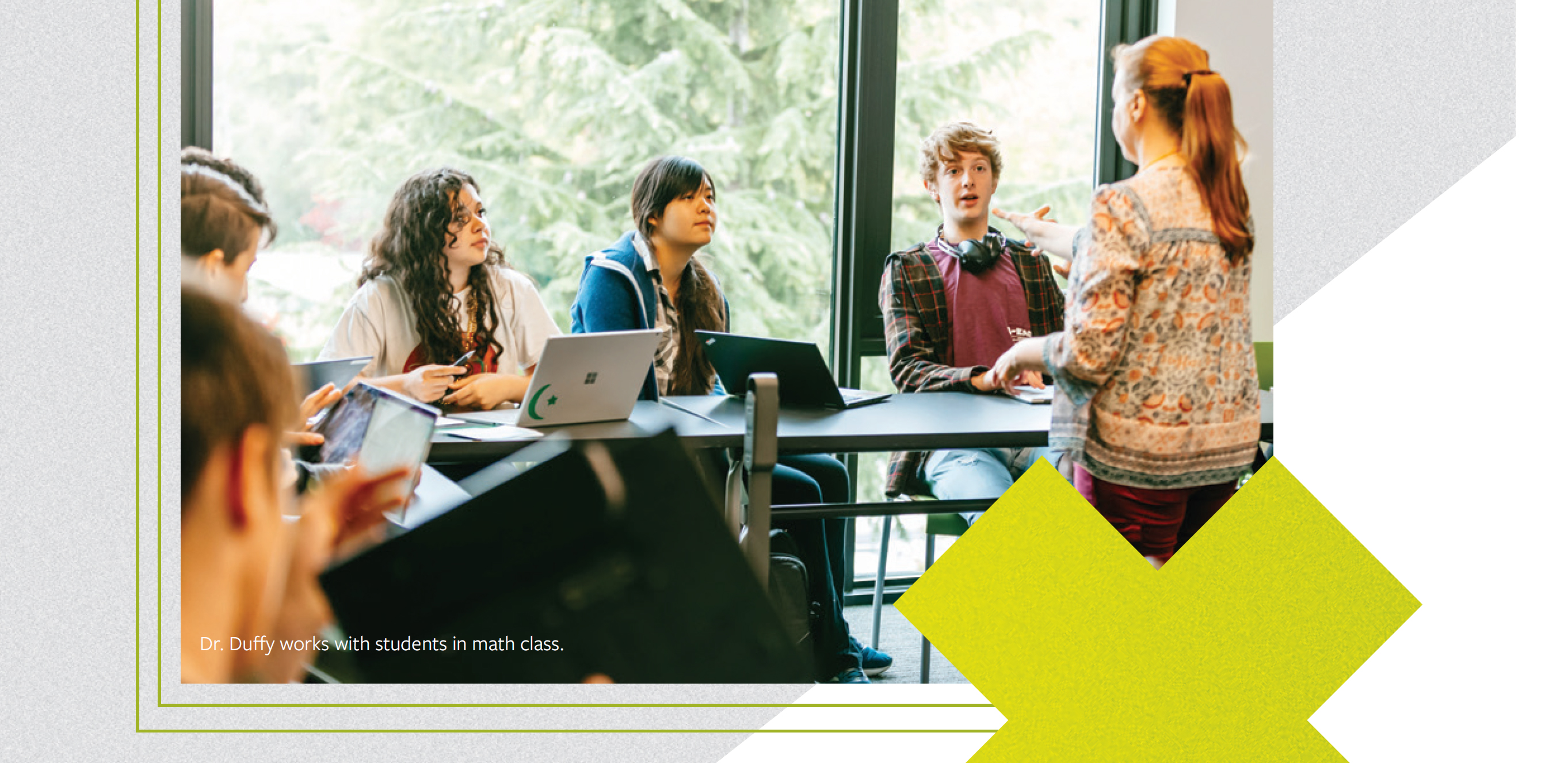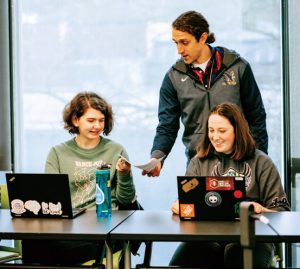
Teaching Math with Intentionality
By Steve Fassino, Math Faculty
3, 9, __, __, __, __, …
WHAT COMES NEXT? WHAT ELSE COULD COME next? The answers probably vary from one person to the next, and that’s great! A well-crafted task like this inspires creativity, increases equity, and generates a conversation centered around mathematical ideas. Intentionally crafting activities like this is one component of teaching math at EPS.
In November 2018, the math discipline had the opportunity to work together off campus by attending the 2018 National Council of Teachers of Mathematics (NCTM) Conference at the Washington State Convention Center. Attending the conference provided a way to welcome our new faculty members and to deepen our bonds in the group.
Evidence has found that young children who show aptitude in math at an early age also grow up to become better readers, both grammatically and in terms of comprehension. And yet, many adults will proudly tell you that they were not good at math, but you seldom see anyone admit to being a poor reader. It is far more socially acceptable to be bad at math because there is a certain “coolness” to not being a math geek. While we are hopeful that these attitudes are changing, to a large extent social media still reinforce this perception.
While being ‘bad at math’ is still all too acceptable, there are also many parents who prioritize math proficiency as a requirement for success in life. This can lead to anxiety in students who struggle and believe that their worth is defined by how well they do in math. Phrases like “we’re a math family” or “everyone in our family is bad at math” only reinforce the idea that math is a genetic trait and not a skill that can be practiced and improved. This stereotype also leads students to believe that no matter how hard they work, they will not succeed because they don’t have a “math gene.” This is reaffirmed by Carol Dweck’s research on fixed and growth mindsets. Several of our math faculty will personally attest to the fact that their success in math is due to hard work and perseverance.
 Given how much hard work is needed to succeed in math, it’s important for students’ efforts to be beneficial to their learning. In our technological age, it’s easy to access tools that either confuse or do the thinking for the user. At EPS we only bring the tools into the classroom that reinforce thinking or help guide a learning experience. Primarily, we use a mix of the Texas Instruments handheld calculators, the online calculator and activity builder DESMOS, and Khan Academy. The interactive technology of DESMOS shows concepts in action and allows students to play with their ideas. At the conference, Dan Meyer, the Chief Academic Officer at DESMOS, emphasized the importance of students forming a hypothesis before being shown the established theorem. Using DESMOS, students can quickly see what the graph of an equation looks like, and what happens if you change a coefficient. For example, in Algebra 2 students often find quadratic equations to be far more complex than the linear functions they previously studied. However, when students input into DESMOS and explore the effect of the values a, h, and k on the graph of this function by pushing the ‘play’ button, they could make connections that were challenging to make on paper. By watching the graph bounce vertically as the k-values cycle through -10 to 10, they connect the equation with a visual. The element of play and immersion in inquiry puts the student in the driver seat of their learning. (For your added entertainment, scan this QR code and go explore for yourself!)
Given how much hard work is needed to succeed in math, it’s important for students’ efforts to be beneficial to their learning. In our technological age, it’s easy to access tools that either confuse or do the thinking for the user. At EPS we only bring the tools into the classroom that reinforce thinking or help guide a learning experience. Primarily, we use a mix of the Texas Instruments handheld calculators, the online calculator and activity builder DESMOS, and Khan Academy. The interactive technology of DESMOS shows concepts in action and allows students to play with their ideas. At the conference, Dan Meyer, the Chief Academic Officer at DESMOS, emphasized the importance of students forming a hypothesis before being shown the established theorem. Using DESMOS, students can quickly see what the graph of an equation looks like, and what happens if you change a coefficient. For example, in Algebra 2 students often find quadratic equations to be far more complex than the linear functions they previously studied. However, when students input into DESMOS and explore the effect of the values a, h, and k on the graph of this function by pushing the ‘play’ button, they could make connections that were challenging to make on paper. By watching the graph bounce vertically as the k-values cycle through -10 to 10, they connect the equation with a visual. The element of play and immersion in inquiry puts the student in the driver seat of their learning. (For your added entertainment, scan this QR code and go explore for yourself!)
MATH AND EQUITY
Technology like DESMOS and Khan Academy pave the way toward a more equitable world by providing everyone with the same free tools. What do we mean when we talk about equity in math class? We mean respecting each student’s voice in the classroom and learning from each other’s mistakes. Understanding common errors benefits everyone’s learning, as does exploring different methods of problem solving. Each correct answer can be arrived at in many ways, and we strive to honor differences in thought processes.
Another area of equity discussed at the conference was detracking and math placement. The president of NCTM, Robert Q. Berry III, has given multiple lectures on detracking efforts across the country. In many school districts, tracking math classes, where students move along a progression deemed “high-achieving,” “normal pace,” or “below normal” results in inequalities along racial and socioeconomic lines. Additionally, conference presenters emphasized the “race to Calculus.” One question our country faces is how the “race to Calculus” impacts classroom equity. Jo Boaler’s research has found evidence that students who speed through content without developing depth of understanding are the very ones who tend to drop out of mathematics when they have the chance.
While all adolescents go through incredible brain growth and transformations, some students benefit from extra strategies like highlighting directions and math symbols. There are also significant differences in the prefrontal cortexes of, say a sixth grader versus an eighth or tenth grader. These prefrontal cortex differences explain why sixth graders think more concretely and need step-by-step directions for projects. By tenth grade, most students think abstractly and can work on more open-ended projects. We see these age differences and learning profiles at Eastside Prep as well.

Mr. Fassino works with Vivienne and Emily (both Class of 2021).
Another theme at the conference addressed the challenge of relating the theoretical to the practical in our classrooms. Let’s start with a real-world question: How much do we recycle at EPS? Answering this question requires a lot of brainstorming and connecting multiple ideas and data, yet students embrace the work because the math feels REAL and accessible—and it is! The process of estimation and generation of a mathematical model requires a rich discussion to refine what we’re trying to measure: Are we focused on recycling collected from just classrooms or the whole campus? Do we produce the same amount of recycling each day? This process of assumption-building requires patience and reasoning. But more importantly, this process is one to which every student can contribute.
Then, after stating our assumptions, gathering data might be needed to help build the model. In this digital age, we have access to an enormous amount of data. For the recycling problem, data might mean we measure how much recycling there is in a set of classrooms at the end of one school day and then scaling up to the size of the campus. After the model is built, we investigate its validity and accuracy. Maybe we notice an incorrect assumption and need to complete the process again, and that’s okay. By the end of the process, the body of work is representative of what students thought about and constructed from their collective thinking. By engaging this type of practical brainstorming, the use of abstract symbols and variables have meaning to them. Put simply, the math is tangible and welcoming.
It is gratifying and affirming that Eastside Prep already has implemented much of what was considered ideal by NCTM; many other schools wish to implement practices that are already a part of the EPS classroom experience. Our intent in the classroom is to challenge each student to reach their own potential and to be a curious, lifelong learner. And we recognize that the partnership we have with parents is a crucial component to putting all of these pieces together. As a math faculty, we look forward to future opportunities to grow and strengthen these relationships as well as our teaching practice.

